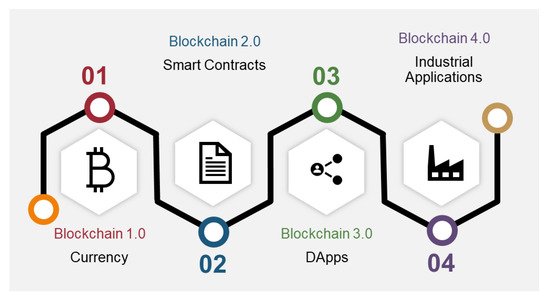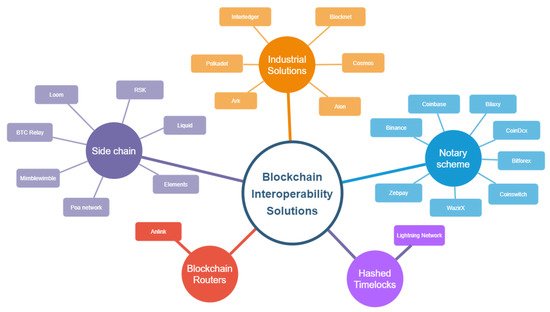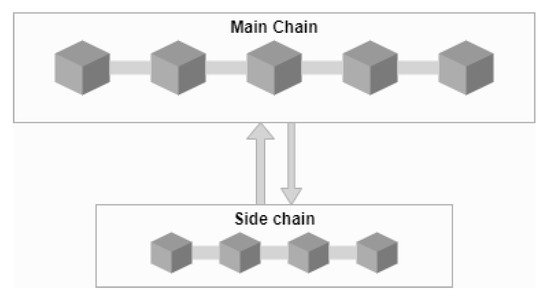You're using an outdated browser. Please upgrade to a modern browser for the best experience.
Please note this is a comparison between Version 1 by Debasis Mohanty and Version 2 by Jessie Wu.
Blockchain Interoperability is defined according to the National Institute of Standards and Technology (NIST) as: “a composition of distinguishable blockchain systems, each representing a unique distributed data ledger, where atomic transaction execution may span multiple heterogeneous blockchain systems, and where data recorded in one blockchain are reachable, verifiable, and referable by another possibly foreign transaction in a semantically compatible manner”.
- blockchain
- interoperabilit
- exchange
1. Introduction
The idea of a chain of blocks called Blockchain was put forward by Satoshi Nakamoto in 2008 [1]. Nakamoto implemented the concept in a peer-to-peer decentralized cryptocurrency called Bitcoin. Blockchain is an immutable, append-only decentralized distributed ledger system that addresses the byzantine fault tolerance problem in centralized ledger systems. The development of Blockchain technology can be divided into four stages [2]. Blockchain 1.0 has cryptocurrency application, Blockchain 2.0 provides smart contracts whereas Blockchain 3.0 develops distributed applications (dapps) that cater to several fields beyond financial applications or asset transfers. Blockchain 4.0 includes industry 4.0 applications. The common use case of blockchain 1.0 is the electronic payment system or cryptocurrency. Different terminologies that refer to Blockchain 2.0 include Bitcoin 2.0, Bitcoin 2.0 protocols, smart contracts, smart property, etc. Ethereum Smart contracts [3], Hyperledger Fabric [4], and R3’s Corda [5] are examples of Blockchain 2.0. Common-use cases of Blockchain 3.0 include dapps for sectors such as governance, IoT, healthcare, supply chain, smart city, and many other non-financial applications. Blockchain 4.0 is focused on distributed ledger technology and real-life blockchain applications for industry 4.0 applications. Blockchain is currently used in several industries, in financial instruments, maintaining public/private records, health records, tangible assets, or intangible assets [6]. Figure 1 represents the evolution of blockchain.

Figure 1.
Evolution of Blockchain.
Due to the wide array of applications of distributed ledger technologies, different organizations have developed their version of Blockchain systems, catering to their need. This led to the in-house development of different blockchain projects using different protocols and architectures. These projects use different technologies, consensus protocols catering to specific use cases or applications. Such a large number of projects have made the development highly fragmented with very little or no interoperability between different blockchain projects. For the wide acceptance of these blockchain-based applications, they need to communicate with other blockchain applications, that are hosted on different blockchain networks. This will create a new system of communication between different isolated blockchain networks, thereby laying a foundation for the concept of interoperability between blockchain networks [7].
2. Technologies for Blockchain Interoperability
A comprehensive literature survey on blockchain interoperability is provided by Belchior et al. [8][21]. The authors broadly categorized blockchain interoperability solutions into the following three categories: Cryptocurrency-directed Approaches, Blockchain Engines, and Blockchain Connectors. The three broad categories are divided into subcategories. Authors in [9][22] categorized inter-blockchain communications into four distinct groups, as follows: sidechains, blockchain routers, smart contracts, and industrial solutions. Robinson [10][23] organized cross-chain solutions into three categories value, namely, swap, cross-chain messaging, and state pinning techniques. Wang [11][24] discussed the current state of blockchain interoperability and broadly categorized blockchain interoperability solutions as chain-based, bridge-based, and dapp-based interoperability. In this section, rwesearchers discuss the underlying technologies for cross-blockchain transactions. ResearchersWe categorize them into notary schemes, sidechain-based solutions, Blockchain routers, Hashed time locks, and Industrial solutions. Many projects implement a combination of mentioned blockchain interoperability technologies. Figure 2 shows the blockchain interoperability solution types and example projects. ResWearchers classify cross-chain transactions as a special application and included them in the subsequent section.

Figure 2.
Blockchain Interoperability solutions and example projects.
2.1. Sidechains
The sidechain has three important components, including the mainchain, sidechain, and cross-chain communication protocol. A sidechain is a mechanism in which two existing blockchains interoperate [12][25]. One blockchain is called the mainchain and the other is called the sidechain. The mainchain maintains a ledger of assets and is connected to the sidechain with a cross-chain communication protocol. Sidechains act as a two-way peg, with a mechanism to transfer assets between the mainchain and sidechain [13][26]. Figure 3 shows the side chain connected with the mainchain. BTC Relay [14][27] is the first project that introduced the concept of relay and sidechain. BTC relay uses a technique called simplified payment verification (SPV). Many lightweight clients use SPV to cryptographically verify if transactions in a blockchain are included without downloading the entire chain. A chain of block headers showing proof of work is held by an SPV client. Merkle tree validation can be achieved with a limited number of inputs and calculations until the root hash. Example projects that use the sidechain technology are Loom [15][28], Elements [16][29], Liquid [17][30], Mimblewimble [18][31], Poa network [19][32] and RSK [20][33].

Figure 3.
Sidechain.
2.2. Notary Schemes
In this scheme, transactions are dependent on a third-party notary. The trust deficit between both the parties of the transaction is managed by a trusted exchange called a notary. Both the parties trust the exchange. The notary can be a centralized exchange or can be a network of exchanges. The operation of notary schemes is solely dependent on the honesty of the notary. However, notary schemes are simple and easy to implement. Another drawback of the scheme is that the presence of a centralized element though a group of notaries decentralizes the scheme. Currently available notary schemes are centralized cryptocurrency exchanges such as Binance [21][34], Coinbase [22][12], Bilaxy [23][35], BitForex [24][36], WazirX [25][37], Zebpay [26][38], CoinDcx [27][39], Coinswitch [28][40].
2.3. Blockchain Routers
The concept of blockchain routers was first introduced by Wang et al. [29][41] in 2017. Blockchain routers facilitate inter-blockchain communication between different blockchain networks. The design of blockchain routers is inspired by the role of routers over the Internet. In blockchain router network architecture, the different blockchain networks such as bitcoin, Ethereum, etc., are regarded as terminal parts called sub-chains in the routing network. Sub-chains cannot directly communication with each other, and they can only communicate with a blockchain router. Inter sub-chain communication is made possible through the blockchain router following a cross-chain communication protocol. A blockchain maintains all information registered on sub-chains. The blockchain router enables inter sub-chain communication and establishes trust bridge cross-chains. The authors introduced four distinct participants in blockchain router architecture as a validator, connector, surveillant, and nominator. The blockchain router uses a practical byzantine fault tolerance algorithm. Blockchain routers can implement different algorithms based on business logic and user requirements. The Anlink blockchain network [30][42] uses Ann-router to provide interoperability across blockchains.
2.4. Industrial Solutions
Industrial solutions are blockchain systems that are developed to cater to specific utilities. A few prominent industrial projects include COSMOS [31][43], Polkadot [32][44] and Interledger [33][45]. COSMOS consists of a network of independent blockchains called zones. Zones use a tendermint consensus protocol. The first zone in a COSMOS network is called a hub. Hub and zones communicate by an inter-blockchain protocol. Interzone token transfer undergoes the COSMOS hub. The COSMOS hub monitors the total amount of tokens held by each zone. Cosmos allows developers to build both permissionless and permissioned blockchains. Polkadot is a heterogeneous multi-chain translation architecture. It enables customized sidechains to connect with a public blockchain. Different blockchains can exchange messages in a secure and trustless manner with Polkadot. Polkadot defines three types of blockchain classes as Parachains, Relay chains, and bridges. The token used in Polkadot is called a dot. Polkadot implements nominated proof-of-stake consensus protocol. Ark [34][46] creates an ecosystem allowing interoperability by using ARK smart bridge technology. ARK smart bridges make connections between standalone blockchains. Other examples of major industrial blockchain interoperability solutions are Blocknet [35][47] and Aion [36][48].
